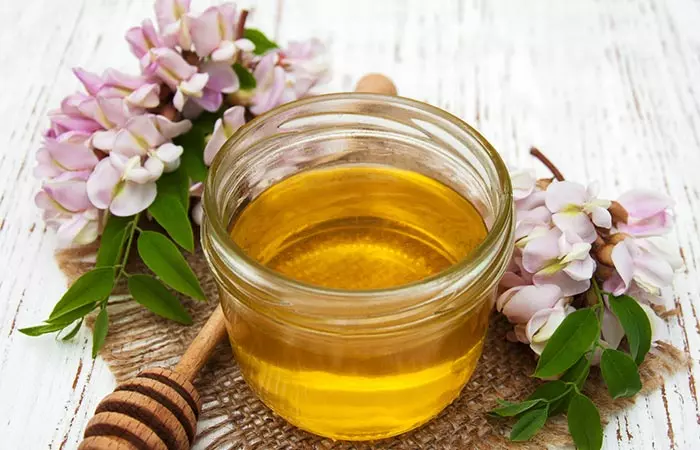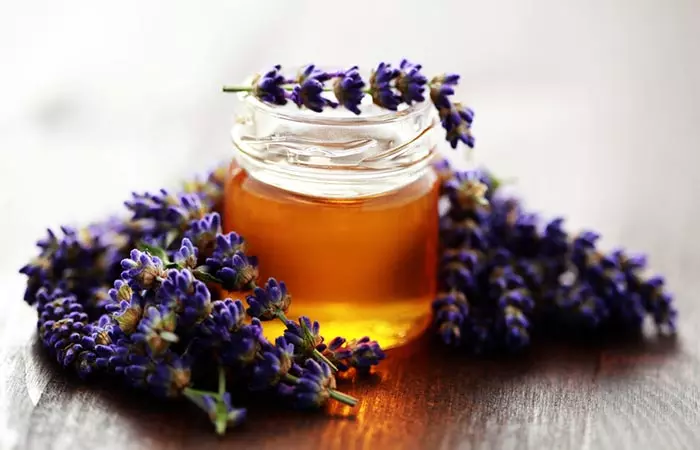If you thought — like many have — that honey comes in just a single variety, brace yourself! You need to get your facts right.
Different types of honey are available on the market, depending on their nutritional composition, color, sources, processing methods, and therapeutic uses. In fact, honey has been used as a natural sweetener for centuries and is still preferred over sugar by many. In this article, we explore each type of honey, their nutritional profiles, medicinal values, and health benefits. Scroll down for all this info and more!
In This Article
What Is Honey?
Honey is an impure and supersaturated sugar solution – a natural, original, sweetener. Its unique (though variable) combination of components makes honey a prized addition to the diet.
It has been used in food for at least 6000 years, mostly as a sweet source for much of the world’s population. The first written reference to honey, inscriptions on a Sumerian tablet dating back to 2100-2000 BC, mentions honey’s use as a drug and an ointment.
Did You Know?
- Honey is the only food that will not spoil. This is due to its low moisture content. Bacteria cannot survive in a medium with such a high osmotic pressure.
- But honey harvested before it is ripe has a higher moisture content and may be vulnerable to spoilage.
- Honey is hygroscopic and absorbs water from the atmosphere if it is not stored in a well-sealed container.
- Honey can be unifloral (from a single flower type) or multifloral (multiple species of flowers); biochemical profiles of both classes vary accordingly.
Honey is produced by six to eleven of the approximately 20,000 species of bees. The bees (most commonly, Apis mellifera) drink nectar from a flower and blend it multiple times with salivary enzymes (diastase and invertase) in their honey sacs.
The floral nectar is chemically transformed into honey when the complex sugars are enzymatically broken down into glucose and fructose, and excess water is evaporated.
Yes, nectar and honey are different! They differ based on their chemical composition. Nectar is an aqueous solution of sugars, amino acids, proteins, lipids, minerals, and other components, whereas, honey is more processed and rich.
Let’s look at what honey’s got.
Related: 16 Best Ways To Use Honey For Dry Skin
What Is The Composition Of Honey?
Depending on the source(s) of nectar, honey can have a variable composition. The average composition of honey samples collected in and around the United States are listed below:
| Chemical Composition of U.S. Honeys | ||
| Component | Average (%) | Range (%) |
| Water | 17.2 | 12.2–22.9 |
| Fructose | 38.4 | 30.9–44.3 |
| Glucose | 30.3 | 22.9–40.7 |
| Sucrose | 1.3 | 0.2–7.6 |
| Other disaccharides | 7.3 | 2.7–16.0 |
| Higher sugars | 1.4 | 0.1–3.8 |
| Gluconic acid | 0.57 | 0.17–1.17 |
| Acids (not including gluconic | 0.43 | 0.13–0.92 |
| Lactones | 0.14 | 0.0–0.37 |
| Minerals | 0.17 | 0.02–1.03 |
| Nitrogen | 0.04 | 0.0–0.13 |
Honey has minerals like potassium, sulfur, chlorine, calcium, phosphorus, magnesium, sodium, iron, copper, and manganese. It also has vitamins B and C.
Now, let’s get to the point. Based on the biochemical composition and nectar source, honey comes in many types. And not all varieties taste and function the same.
Explore more about each (unifloral) variety in the next sections!
Related: Is Honey Good For The Face And Skin? How To Use It?
What Are The Different Types Of Honey?
Based on its texture, honey can be either liquid, granulated, creamed, chunked, or can be of an unprocessed form (called comb honey).
Depending on the level of processing, honey can again be divided into raw and pasteurized forms. Raw honey is the crude form. It is directly extracted from the comb before being sent for any refinement. It has the highest therapeutic value. Pasteurized honey is obtained after heating and straining it to get rid of the bacterial or fungal contamination.
Another classification of honey is based on the nectar source. Honey produced by bees that drink nectar from a single species of flowers is unifloral honey. But if the nectar comes from more than one species of flowers, then it is multifloral honey.
These floral types of honey are replete with active phytochemicals and differ from each another. Take a look at what each unifloral variety has.
In This Article
- Manuka Honey
- Alfalfa Honey
- Eucalyptus Honey
- Acacia Honey
- Buckwheat Honey
- Clover Honey
- Sage Honey
- Lavender Honey
- Rosemary Honey
- Jamun Honey
1. Manuka Honey

Image: Shutterstock
Manuka honey is produced by bees that feed on the flowers of the New Zealand Manuka bush (Leptospermum scoparium). It contains high concentrations of methylglyoxal (MGO) and dihydroxyacetone, which may account for its antibacterial activity.
Applying manuka honey on wounds stimulates the formation of new blood cells and promotes the growth of fibroblast and epithelial cells. This honey has potential wound-healing (vulnerary) activity (1).
It is rich in vitamins B1, B2, B3, B5, and B6, and amino acids lysine, proline, arginine, and tyrosine. It also contains minerals like calcium, magnesium, copper, potassium, zinc, and sodium.
Trivia Manuka honey is known for its damp, earthy, and herbaceous aroma with a slightly bitter and rich flavor.
2. Alfalfa Honey
Coming from the alfalfa (Medicago sativa) flowers, alfalfa or lucerne honey is famous for its prebiotic effects.
It has fructooligosaccharides that promote intestinal bacteria and improve digestion (2). Having alfalfa honey regularly can treat anemia, diabetes, and fever (antipyretic agent).
Try warm waffles, cookies, cheese or yogurt with alfalfa honey. Absolute heaven!
3. Eucalyptus Honey
Unifloral honey derived from the flowers of eucalyptus (Eucalyptus rostrata) has luteolin, kaempferol, quercetin, myricetin, and ellagic acid (3). This honey acts as a powerful antioxidant and anti-inflammatory agent. Eucalyptus honey has sodium, potassium, manganese, magnesium, iron, copper, and zinc.
Eucalyptus honey can particularly be helpful for children with compromised immunity (4).
4. Acacia Honey

Image: Shutterstock
Acacia honey is a pale, liquid glass-like honey produced by bees that feed on Acacia flowers. It contains vitamins A, C, and E, flavonoids, and essential fatty and amino acids.
Acacia honey has hepatoprotective (liver) and nephroprotective (kidney) effects. Oral and topical administration of acacia has shown tissue proliferative and vulnerary (wound healing) properties. Studies also demonstrate effective healing properties of acacia honey in corneal (eye) injuries.
This honey variant possesses anti-inflammatory, anticancer, DNA protective, and antioxidant properties too (5).
5. Buckwheat Honey
Image: IStock
A study on buckwheat honey claimed that serum antioxidant capacity increased by 7% (6). Honey from buckwheat (especially Fagopyrum esculentum) has high bactericidal properties.
Buckwheat honey variants from Canada can kill multi-drug resistant Staphylococcus aureus (MRSA) and other notorious pathogens (7).
Due to its antioxidant properties and an abundance of micro- and macronutrients, buckwheat honey can protect your body and DNA from chemical or oxidative stressi XAn imbalance of free radicals and antioxidants in the body, which can lead to cell and tissue damage. – better than manuka honey (8).
6. Clover Honey
Image: IStock
Clover (from Trifollum species) honey is one of the safest dietary antibacterial agents you can get.
Unlike manuka, this honey doesn’t have methylglyoxal and doesn’t need hydrogen peroxide for its antibacterial effect. It is, hence, not a broad-spectrum antimicrobial agent.
Clover honey has unique phenolic compounds, along with the bee-derived antimicrobial peptides. These could be responsible for the specific antioxidant and antimicrobial activity against Pseudomonas, Bacillus, Staphylococcus species (9).
7. Sage Honey
One of the dark-colored, thicker honey varieties, sage honey is known for its greater sweetening and antioxidant properties. The Californian sage honey is famous for its aroma and flavor.
It has antibacterial, antioxidant, expectoranti XAn ingredient or medication used to treat coughs, relieve congestion, and loosen mucus from the airways. , and digestive properties. This honey type may also control diabetes.
Related: Honey For Acne: 17 Best Ways To Use It For Maximum Benefits
8. Lavender Honey

Image: Shutterstock
Lavender honey is rich in phenolic compounds, amino acids, sugars, and essential enzymes. It has potent antifungal activity against Candida species – thanks to these bioactive elements (10).
Though not as high as manuka honey, lavender honey too possesses antioxidant capacity because of its vitamin C, catalase, and flavonoids. It is used to treat foot ulcers and other fungal infections on the skin (11).
9. Rosemary Honey
Rosemary honey is produced from Rosmarinus officinalis and is widely used in European countries. It is rich in kaempferol, an antioxidant (12).
Rosemary honey can be used in emulsions and cosmetics to lock the moisture in the skin. Due to its physicochemical properties, rosemary honey can be used as a natural moisturizing agent with a high therapeutic value (13).
Did You Know? Rosemary honey is light yellow with a strong flavor. It may not be pure if it is medium to dark yellow or brownish in color.
10. Jamun Honey
Jamun (Syzygium cumini) honey is famous for its antihypoxici XAn ingredient or medication that prevents the body’s tissues from having less dissolved oxygen, maintaining a healthy, steady state. activity. A specific dose of this honey can be topically applied to cure the deadly Fournier gangrenei XAn uncommon, fatal flesh-eating bacterial disease that damages genital soft tissues, including the blood vessels and nerves. .
Since it has high osmotic pressure and viscosity, it prevents microbial growth and promotes wound healing when applied to the affected areas (14).
That was our list of 10 unifloral honey varieties.
It is evident that each variety has a specialty. You can universally use honey to clean and dress your wounds, cure a dry cough, or boost the antioxidant levels in your body.
If you are looking for a wholesome solution with more potent therapeutic applications, you can read up more about multifloral honey types.
FYI, honey has almost no side effects. Nothing major has been documented in any trustworthy source.
Subscribe
Infographic: 6 Types Of Honey You Should Know About
If you thought there was only one type of honey, you are sorely wrong. This ancient and popular sweetener and its variants have been used for centuries due to its differing nutritional profile and medical properties. That is why it is important to know which type of honey is suitable for your needs. We have compiled a list of 6 different types of honey you should know about in the infographic below.

Illustration: StyleCraze Design Team
Save the high-quality PDF version on your device now.
Download Infographic
Honey is a natural sweetener with a rich nutritional profile and medicinal properties. You can find different types of honey on the market – based on their nutritional breakdown, color, processing methods, and sources. Manuka, alfalfa, eucalyptus, acacia, and buckwheat are some important types of honey. In addition, you can find granulated, liquid, creamed or unprocessed forms of honey. Each honey type has a unique texture and taste based on its biochemical composition. Hence, check the nutrition and chemical breakdown of your favorite honey before making the purchase.
Frequently Asked Questions
Which honey is the sweetest?
Locust honey is generally considered the sweetest of all honey types. This honey is considered to be 5 times sweeter than any other honey.
Is black honey real?
Yes, black honey is real. However, it is produced not from trees but raw sugar cane plants through a mechanical process.
What type of honey is healthiest?
Raw and unprocessed honey is considered the healthiest. However, moderate consumption of honey is advised.
What is Grade A honey?
It is honey with top quality, flavor, and clarity. Soluble solids, aroma, flavor, and defects are considered while grading honey.
References:
1. “The Chemical Composition of Honey” Chemistry for Everyone, Journal of Chemical Education
2. “Traditional and Modern Uses of Natural…” Iranian Journal of Basic Medical Sciences, US National Library of Medicine
3. “Manuka honey” NCI Drug Dictionary, National Cancer Institute
4. “Honey as a Complementary Medicine” Integrative Medicine Insights, US National Library of Medicine
5. “Identification of flavonoid markers…” Journal of Agricultural and Food Chemistry, US National Library of Medicine
6. “Characterization of Argentine honeys…” Chemistry Central Journal, US National Library of Medicine
7. “Potential biological activity of Acacia honey” Frontiers in Bioscience (Elite edition), US National Library of Medicine
8. “Buckwheat honey increases serum…” Journal of Agricultural and Food Chemistry, US National Library of Medicine
9. “Powerful bacterial killing by buckwheat…” Frontiers in Microbiology, US National Library of Medicine
10. “Biochemical properties, antibacterial and cellular…” Food Chemistry, US National Library of Medicine
11. “The Effect of New Zealand Kanuka, Manuka and…” PLoS One, US National Library of Medicine
12. “Antifungal effect of lavender honey…” Journal of Food Science and Technology, US National Library of Medicine
13. “Antibacterial and Antioxidant Potency…” Molecules 2012
14. “Evaluation of pollen as a source of…” Journal of the Science of Food and Agriculture, ResearchGate
15. “Pharmacotechnical characterization and effectiveness…” Bollettino chimico farmaceutico, US National Library of Medicine
16. “Honey dressing beneficial in treatment…” Indian Journal of Surgery
Was this article helpful?
“>
Related
The following two tabs change content below.
- Reviewer
- Author

Anna Jones, MS, RD, LD/N


Anna is a Registered Dietitian who is truly passionate about helping people make healthy, lasting lifestyle changes through balanced, nutrient rich nutrition and increased physical activity. She earned both her Bachelor and Masters degree in Health and Nutrition and has over 15 years of experience in the field of health and wellness. She loves helping people learn easy, practical ideas…View Profile ›
Swathi Handoo, Health & Wellness Writer

Swathi holds a master’s degree in biotechnology from Osmania University and has worked in places where actual science and research happen. She has four years of experience and a Professional Certificate in Food, Nutrition & Research from Wageningen University. Blending her love for writing with science, Swathi writes articles on health and wellness and simplifies complex topics for readers from…View Profile ›
